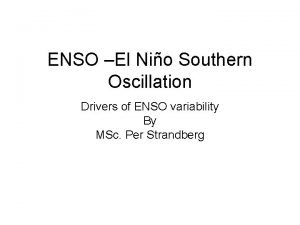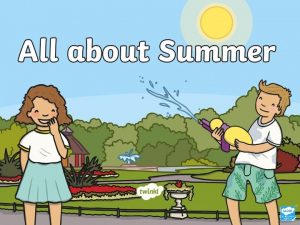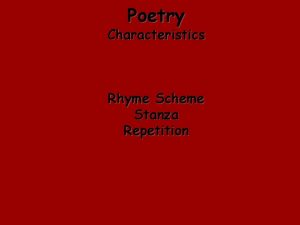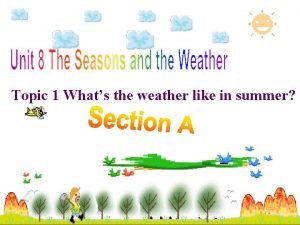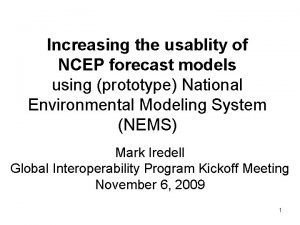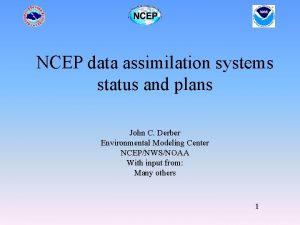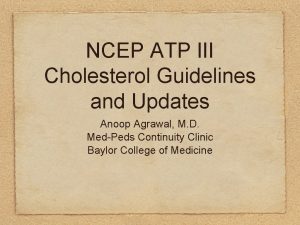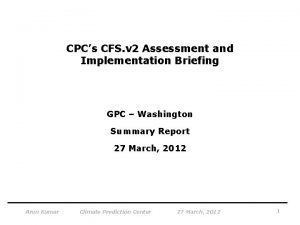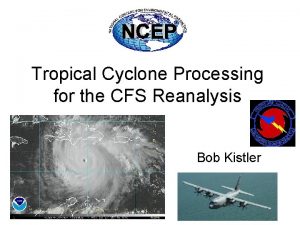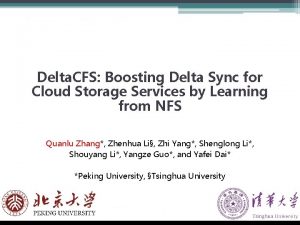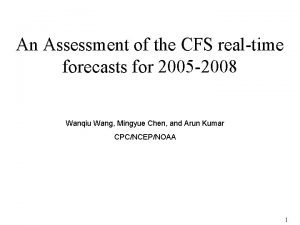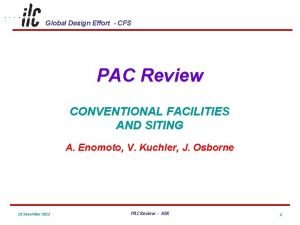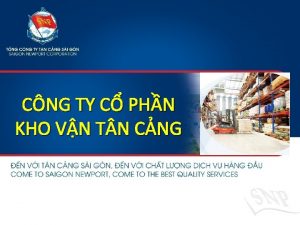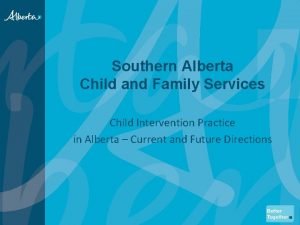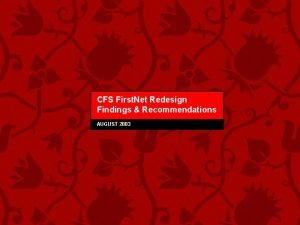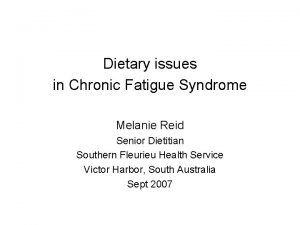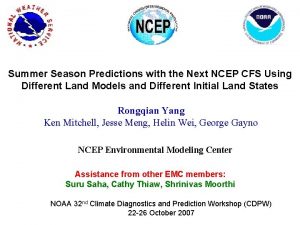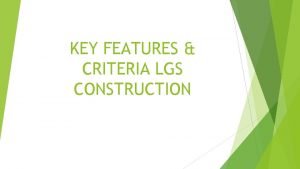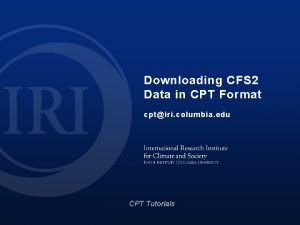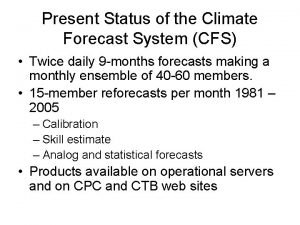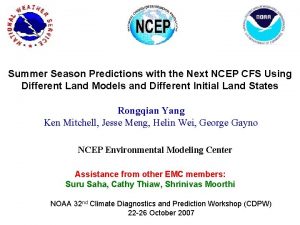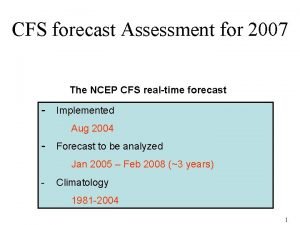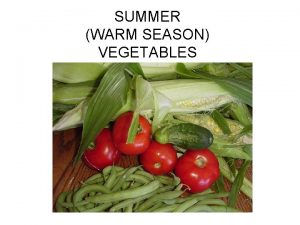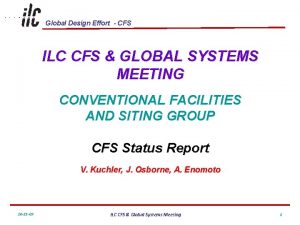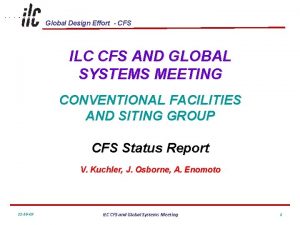Summer Season Predictions with the Next NCEP CFS















![Monthly Time Series (1985 -2004) of Area-mean Illinois 2 -meter Soil Moisture [mm]: Observations Monthly Time Series (1985 -2004) of Area-mean Illinois 2 -meter Soil Moisture [mm]: Observations](https://slidetodoc.com/presentation_image/f23884a4e27a1073e7745c4c7b0e1805/image-16.jpg)








- Slides: 24

Summer Season Predictions with the Next NCEP CFS Using Different Land Models and Different Initial Land States Rongqian Yang Ken Mitchell, Jesse Meng, Helin Wei, George Gayno NCEP Environmental Modeling Center Assistance from other EMC members: Suru Saha, Cathy Thiaw, Shrinivas Moorthi NOAA 32 nd Climate Diagnostics and Prediction Workshop (CDPW) 22 -26 October 2007

Outline • Operational CFS – CONUS summer season forecast skill: precip, 2 m-T, Pacific SST • Next-generation CFS – Analysis & physics upgrades: Atmos, Ocean, Land, Sea-Ice – Double horizontal resolution – CO 2 trend • CFS Experiment Design: Land & Summer Emphasis – Land Models: Two models (Noah LSM, OSU LSM) – Land initial states: Two sources (Global Reanal 2, GLDAS) • CFS Experiment Results: – CONUS precipitation & 2 -m air temperature – Pacific SST • Conclusions & Future Work – Future Work: winter runs

Performance of Currently Operational CFS: (shown in next four frames) -- SST (high correlation skill in tropical Pacific), -- CONUS precipitation (low correlation skill in summer) -- CONUS 2 -m air temperature (low correlation skill in summer)

CFS Tropical Pacific SST skill is very competitive with empirical methods & their composite 15 -member CFS reforecasts

Ops CFS Seasonal SST Forecast Skill: Correlation of CFS SST forecast with observed SST over 1982 -2003 For April initial conditions: 15 -member ensemble mean Correlation skill of SST prediction for central and eastern tropical Pacific is rather high 1 -Month Lead 6 -Month Lead More examples at: http: //www. cpc. ncep. noaa. gov/products/people/wwang/cfs_skills/

Ops CFS Seasonal Precipitation Forecast Skill: Correlation of CFS precip forecast with observed precip: 1982 -2003 For April initial conditions: 15 -member ensemble mean Short-lead summer forecast correlation skill is low across bulk of CONUS (lower than longer-lead winter forecast) 1 -Month Lead (valid summer) 6 -Month Lead (valid winter) More examples at: http: //www. cpc. ncep. noaa. gov/products/people/wwang/cfs_skills/

Ops CFS Seasonal Temperature Fcst Skill over CONUS: Correlation of forecast with observed 2 m. T over 22 -year hindcast For April initial conditions: 15 -member ensemble mean Short-lead summer forecast correlation skill is low across majority of CONUS More examples at: http: //www. cpc. ncep. noaa. gov/products/people/wwang/cfs_skills/

Experimental CFS versus Ops CFS: See workshop Monday presentation by Hua-Lu Pan et al. • Upgrades to CFS physics – Atmosphere, ocean, land, sea-ice • Double the CFS resolution – T 126 / L 64 versus T 62 / L 28 • New CFS vertical coordinate – Hybrid sigma-pressure versus sigma • New analysis systems – Atmosphere, ocean, land The CFS experiments presented below incorporate the upgrades highlighted above in red, with a focus on the land upgrades.

Experimental CFS: Land Model Upgrade Noah LSM (new) versus OSU LSM (old): • Noah LSM – 4 soil layers (10, 30, 60, 100 cm) – Frozen soil physics included – Surface fluxes weighted by snow cover fraction – Improved seasonal cycle of vegetation cover – Spatially varying root depth – Runoff and infiltration account for sub-grid variability in precipitation & soil moisture – Improved soil & snow thermal conductivity – Higher canopy resistance – Other • OSU LSM – 2 soil layers (10, 190 cm) – No frozen soil physics – Surface fluxes not weighted by snow fraction – Vegetation fraction never less than 50 percent – Spatially constant root depth – Runoff & infiltration do not account for subgrid variability of precipitation & soil moisture – Poor soil and snow thermal conductivity, especially for thin snowpack Noah LSM replaced OSU LSM in operational NCEP medium-range Global Forecast System (GFS) in late May 2005

Annual mean biases in surface energy fluxes: In five operational GCMs during 2003 -2004 w. r. t. nine flux-station sites distributed world-wide from K. Yang et al. (2007, J. Meteor. Soc. Japan) Mean Bias Error (MBE) Pre-May 2005 NCEP GFS had large positive bias in surface latent heat flux and corresponding large negative bias in surface sensible heat flux. l. E – Latent Heat Flux H – Sensible Heat Flux Rn – Net Radiation µ – Global mean

Mean GFS surface latent heat flux: 09 -25 May 2005: Upgrade to Noah LSM significantly reduced the GFS surface latent heat flux (especially in non-arid regions) Pre-May 05 GFS: with OSU LSM Post-May 05 GFS: with new Noah LSM

CFS Land Experiments: 4 configurations Experiments of T 126 CFS with CFS/Noah and CFS/OSU 25 -year summer reforecasts (10 member ensembles) from April initial conditions of 1980 -2004 Choice of CFS/Noah GR 2/OSU Choice of Land Initial Conditions Land Model CFS/OSU GR 2/OSU (CONTROL) GLDAS/Noah Climo Note: “GR 2” denotes NCEP/DOE Global Reanalysis 2

CFS Land-Focus Reforecast Experiments Objective: Demonstrate Impact on CFS of: A) new land model (Noah LSM vs OSU LSM) B) new land initial conditions (GLDAS vs GR 2) 25 -year (1980 -2004) 10 -member 6 -month T 126 CFS runs ( GFS-OP 3 T 3, MOM-3 ) • – • • Four configurations of T 126 CFS: A) CFS/OSU/GR 2: - OSU LSM, initial land states from GR 2 (CONTROL) B) CFS/Noah/GR 2: - Noah LSM, initial land states from GR 2 C) CFS/Noah/GLDAS: - Noah LSM, initial land states from T 126 GLDAS/Noah D) CFS/Noah/GLDAS-Climo: - Noah LSM, initial land states from GLDAS/Noah climo • Initial conditions: 00 Z daily from Apr 19 -23 29, 30, and May 1 -3 – 5 additional members for A) and C) configurations Initial conditions: 00 Z daily from Apr 24 -28 Key Theme From Results that Follow: Results below show that configuration B is clearly the worst configuration for CONUS JJA precipitation, which illustrates that you must provide a new land model with initial conditions that are produced in a data assimilation anchored by the same new land model. NOTE: “GR 2” above denotes NCEP/DOE Global Reanalysis 2

GLDAS versus Global Reanalysis 2 (GR 2): Land Treatment • GLDAS: an uncoupled land simulation system driven by observed precipitation analyses (CPC CMAP analyses) – Executed using same grid, land mask, terrain field and Noah LSM as GFS in experimental CFS – Non-precipitation land forcing is from GR 2 – Executed retrospectively from 1979 -2006 (after spin-up) • GR 2: a coupled atmosphere/land assimilation system wherein land component is driven by model predicted precipitation – applies the OSU LSM – nudges soil moisture based on differences between model and CPC CMAP precipitation

GLDAS/Noah (top ) versus GR 2/OSU (bottom) 2 -meter soil moisture (% volume) May 1 st Climatology GLDAS/Noah GR 2/OSU 01 May 1999 Anomaly GLDAS/Noah GR 2/OSU Left column: GLDAS/Noah soil moisture climo is generally higher then GR 2/OSU Middle column: GLDAS/Noah soil moisture anomaly pattern agrees better than that of GR 2/OSU with observed precipitation anomaly (right column: top) Observed 90 -day Precipitation Anomaly (mm) valid 30 April 99
![Monthly Time Series 1985 2004 of Areamean Illinois 2 meter Soil Moisture mm Observations Monthly Time Series (1985 -2004) of Area-mean Illinois 2 -meter Soil Moisture [mm]: Observations](https://slidetodoc.com/presentation_image/f23884a4e27a1073e7745c4c7b0e1805/image-16.jpg)
Monthly Time Series (1985 -2004) of Area-mean Illinois 2 -meter Soil Moisture [mm]: Observations (black), GLDAS/Noah (purple), GR 2/OSU (green) Total Climatology Anomaly The climatology of GLDAS/Noah soil moisture is higher and closer to the observed climatology than that of GR 2/OSU, while the anomlies of all three show generally better agreement with each other (though some exceptions)

Results of CFS Experiments: All remaining frames

JJA Precipitation Correlation Skill CFS/Noah/GR 2 case is clearly worst case (least spatial extent of positive correlation). Remaining three cases appear to have similar spatial extent of positive correlation, but distributed differently among sub-regions. Still disappointingly small spatial extent of correlations above 0. 5 in all four configurations. From hindcasts for years 1981 -2004. Ten-member ensemble mean shown for each panel.

JJA Precipitation Correlation Skill As in previous frame, except Ops CFS result now shown in upper right panel. Compared to Ops CFS, the three viable experimental CFS configurations do not show notably higher spatial extent of positive correlation nor notably higher values of positive correlation. Still disappointingly small spatial extent of correlations above 0. 5 in all four configurations.

JJA T 2 m Correlation Skill OSU/GR 2 somewhat better over CONUS & Noah/GLDAS worst over Canada Noah/ GLDAS Noah/ GR 2 Noah/ GLDAS Climo OSU/ GR 2 10 Members each case (same initial dates)

JJA T 2 m Correlation Skill All experimental configurations better than Ops CFS, mostly likely due to CO 2 trend included in experimental CFS but absent in ops CFS Noah/ GLDAS Noah/ GR 2 Noah/ GLDAS Climo Ops CFS This Frame same as previous, except Ops CFS (from 15 members) shown in lower right.

JJA SST Correlation Skill All four configurations yield similar SST correlation patterns CFS Noah/GLDAS Climo CFS Noah/GR 2 CFS OSU/GR 2

JJA SST Correlation Skill Ops CFS (lower right) better in Nino 3. 4 but worse over western warm pool CFS Noah/GLDAS Climo CFS Noah/GR 2 Ops CFS This Frame same as previous, except Ops CFS (from 15 members) shown in lower right.

Conclusions & Future Work • The relatively low CFS seasonal prediction skill for summer precipitation over CONUS is not materially improved by the tested upgrade in land surface physics and land data assimilation • An upgrade to the land surface model of a GCM can possibly degrade GCM performance if the upgraded land model is not also incorporated into the data assimilation suite that supplies the initial land states • The addition of a CO 2 trend to the experimental CFS is likely the major source of the improvement in experimental CFS summer season surface temperature forecasts relative to the currently operational CFS – The land model and land assimilation upgrades did not appear to materially increase the summer season surface temperature prediction skill of the CFS • The use of initial soil moisture states with instantaneous soil moisture anomalies did not appear to provide an advantage over climatological soil moisture states, provided the soil moisture climatology was produced by the same land model being tested in the GCM • The Tuesday workshop poster by Soo-Hyun Yoo et al. evaluated these same CFS experiments over the Asian-Australian Monsoon, showing modestly positive impact over that region from the land model upgrades presented here • Future work will carry out this same suite of experiments for winter season hindcasts.
 X.next = x.next.next
X.next = x.next.next How next year predictions
How next year predictions Summer is one season
Summer is one season Summer is one season
Summer is one season Standards rhyme
Standards rhyme How's the weather in summer
How's the weather in summer Poems about summer
Poems about summer Ncep models
Ncep models Ncep model status
Ncep model status Ncep atp iii guidelines
Ncep atp iii guidelines Cfs version 2
Cfs version 2 Tcvitals
Tcvitals Cfs
Cfs Cfs forecast
Cfs forecast Cfs
Cfs Cfs saigonnewport
Cfs saigonnewport Southern alberta child intervention services
Southern alberta child intervention services Cfs firstnet
Cfs firstnet Cfs food service
Cfs food service Aznm
Aznm Mutaflor cfs
Mutaflor cfs Cfs
Cfs Pinnacle cfs framing
Pinnacle cfs framing Cfs format
Cfs format Cfs climate forecast system
Cfs climate forecast system

